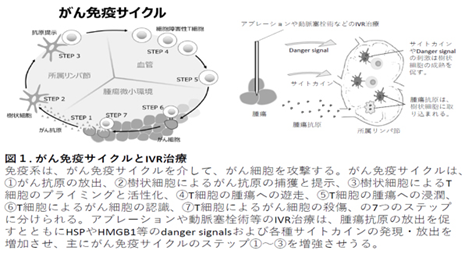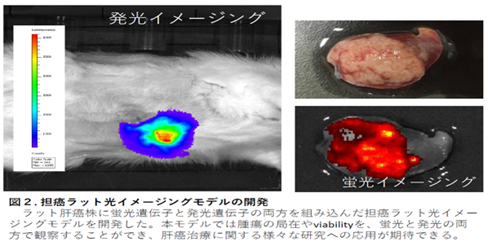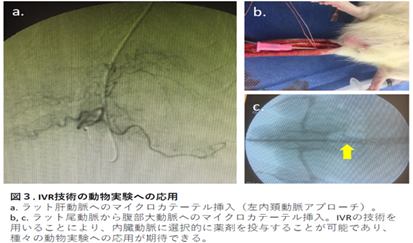Development of new treatment strategies combining cancer IVR and immunotherapy
Information updated: July 31, 2023
- Seeds Information
- Researcher Information
- What do you expect from collaboration with companies?
- Contact for this research
Seeds Information
keyword
IVR Radiofrequency coagulation therapy, cryotherapy, arterial embolization, portal vein embolization, immunotherapy, immune checkpoint, hypoxic response, hypoxia-inducible factor, drug delivery
Field
Pharmaceuticals/Medical Devices, Bio
Overview
Interventional Radiology (IVR) is a field of Department of Radiology that is a minimally invasive medical treatment using diagnostic imaging equipment. Representative IVR treatments include transcatheter arterial embolization (TAE) and ablation treatment for solid tumors.
After IVR treatment, the immune balance in the tumor microenvironment may change due to tumor-specific immune responses elicited by necrotic cancer cells remaining locally as a source of tumor antigens, or due to various cytokines and chemokines induced by local inflammation.
Aiming to develop a new IVR treatment strategy for solid cancers, we conducted research focusing on changes in immune balance after IVR treatment and found that hypoxic stimulation after IVR treatment promotes the cancer immune escape mechanism.
We are currently aiming to establish a new therapeutic strategy based on this phenomenon, and are also developing a new drug delivery system (DDS) necessary for this purpose.
What's new?
Using IVR technology, it is possible to insert a microcatheter into a visceral artery to selectively inject various modalities (drugs, nucleic acids, cells, etc.) into an organ, or to insert a thin needle under ultrasound guidance to locally inject various modalities (drugs, nucleic acids, cells, etc.) into any desired target.
What are its advantages over other studies?
Unlike conventional mouse subcutaneous tumor models, we conduct research using an orthotopic tumor-bearing model in rats, which allows us to conduct research using a model that is closer to the actual disease.
We have developed a tumor-bearing rat optical imaging model in which fluorescent and luminescent genes have been introduced into a rat hepatoma cell line, and the progression of cancer and the effects of treatment can be evaluated non-invasively using an in vivo imaging system (IVIS).
What problem does it help solve?
Development of new interventional radiology treatment strategies for solid cancers
Improving the efficacy of immunotherapy and developing new treatment strategies
Possibility of other applications and developments
A new DDS using IVR technology has made it possible to administer various modalities (drugs, nucleic acids, cells, etc.) selectively to the liver and/or kidneys, which can be applied to the development of treatments for various diseases, including not only malignant tumors but also metabolic diseases, liver cirrhosis, and renal failure.
Similarly, it is expected that this technology will also be applied to regenerative medicine for the liver and kidneys.
Related Patents
―
Related papers
- Takaki H, et al. Radiofrequency Ablation by a 21-Gauge Internally Cooled Electrode: Ex Vivo and In Vivo Evaluation by Rat Liver. Cardiovasc Intervent Radiol. 2021 Jan;44(1):150-155.
- Takaki H, et alK. Hepatic Artery Embolization Enhances Expression of Programmed Cell Death 1 Ligand 1 in an Orthotopic Rat Hepatocellular Carcinoma Model: In Vivo and in Vitro Experimentation. J Vasc Interv Radiol. 2020 Sep;31(9):1475-1482.e2.
- Srimathveeravalli G, Takaki H, et al. Reversible Electroporation-Mediated Liposomal Doxorubicin Delivery to Tumors Can Be Monitored With (89)Zr-Labeled Reporter Nanoparticles.Mol Imaging. 2018 Jan-Dec;17:1536012117749726.
- Takaki H, et al. Thermal ablation and immunomodulation: From preclinical experiments to clinical trials. Diagn Interv Imaging. 2017 Sep;98(9):651-659.
- Takaki H, et al. Peripheral Blood Regulatory T-Cell and Type 1 Helper T-Cell Population Decrease after Hepatic Artery Embolization. J Vasc Interv Radiol. 2016;27:1561-8.
Researcher Information
| full name | Haruyuki Takagi |
|---|---|
| Affiliation | School of Medicine Department of Radiology |
| Specialization | Pharmaceuticals/Medical Devices Bio |
| Collaborative Researcher | ― |
| Related links | Laboratory website |
What do you expect from collaboration with companies?
We would like to collaborate on research and development in the development of new therapeutic strategies for cancer interventional radiology treatment (combined use with antibody therapy, nucleic acid therapy, etc.) and the development of new devices (embolic materials, ablation devices, etc.).
Contact for this research
兵庫医科大学 大学事務部 研究推進課
E-mail: chizai@hyo-med.ac.jp
Tel: 0798-45-6488

 Research Seeds Collection
Research Seeds Collection


